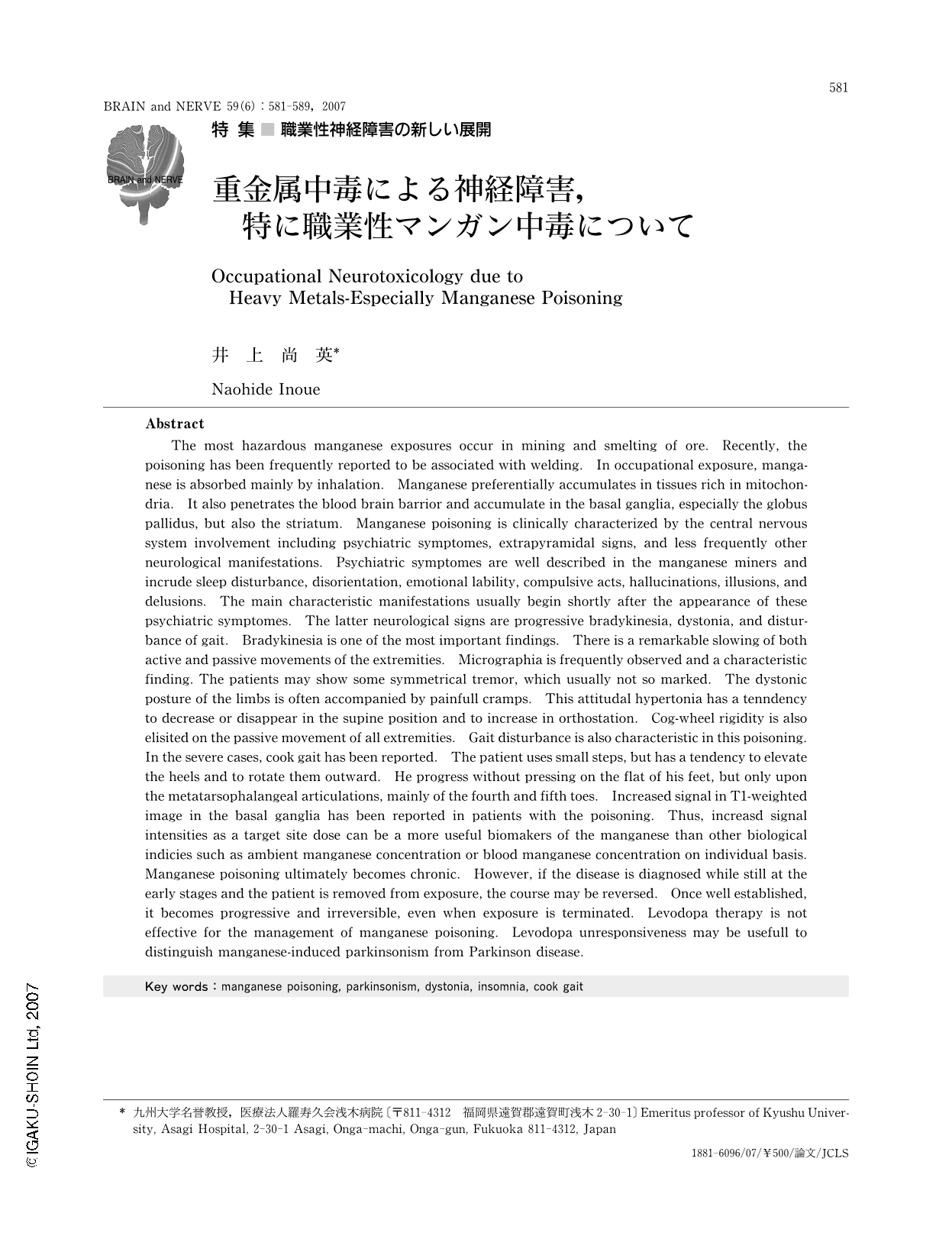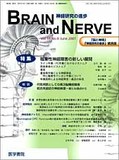Japanese
English
- 有料閲覧
- Abstract 文献概要
- 1ページ目 Look Inside
- 参考文献 Reference
はじめに
1837年に英国のCouper1)が,最初にマンガン中毒について報告した。20世紀初頭から中毒例が発生し始めた。第二次世界大戦の勃発とともに戦時産業への鉄鋼需要の増大に伴い,マンガン鉱山における採鉱量も飛躍的に増大した。それとともにマンガン鉱山の労働者の数も増え,中毒例が急増している。そして,1960年頃までに少なくとも400例以上もの中毒例が報告されている。これらすべてが職業病性の慢性中毒であり,そのほとんどが,マンガン鉱山や鋼鉄の溶融で中毒が発生したものである。その後は世界的に減少傾向にある。
しかし,現在でもこのマンガン中毒は,鉱石産出国や発展途上国においては主要な職業病として注目されている。また,マンガンを含有する鋼鉄を切断したり,溶接する溶接工では,マンガン中毒が起こりやすいとされている。
近年,溶接作業者にマンガン中毒が多発しているという報告が相次いでなされており,頭部MRI検査できわめて特徴的な所見がみられること2)もあり,マンガン中毒が職業病として新たに大きな注目を浴びてきている3)。
マンガン中毒は,職業曝露のみならず一般環境下においても起こることが報告されており,身近な金属中毒となってきている。長期にわたる経管栄養でも,マンガンの蓄積により典型的な中毒症状の発現をみるとされている。
本稿では,職業性曝露によるマンガン中毒を中心に,新しい知見を交えて曝露状況,中毒症状,臨床検査所見,診断と治療を中心に詳細に述べることとする。
Abstract
The most hazardous manganese exposures occur in mining and smelting of ore. Recently,the poisoning has been frequently reported to be associated with welding. In occupational exposure,manganese is absorbed mainly by inhalation. Manganese preferentially accumulates in tissues rich in mitochondria. It also penetrates the blood brain barrior and accumulate in the basal ganglia,especially the globus pallidus,but also the striatum. Manganese poisoning is clinically characterized by the central nervous system involvement including psychiatric symptomes,extrapyramidal signs,and less frequently other neurological manifestations. Psychiatric symptomes are well described in the manganese miners and incrude sleep disturbance,disorientation,emotional lability,compulsive acts,hallucinations,illusions,and delusions. The main characteristic manifestations usually begin shortly after the appearance of these psychiatric symptomes. The latter neurological signs are progressive bradykinesia,dystonia,and disturbance of gait. Bradykinesia is one of the most important findings. There is a remarkable slowing of both active and passive movements of the extremities. Micrographia is frequently observed and a characteristic finding. The patients may show some symmetrical tremor,which usually not so marked. The dystonic posture of the limbs is often accompanied by painfull cramps. This attitudal hypertonia has a tenndency to decrease or disappear in the supine position and to increase in orthostation. Cog-wheel rigidity is also elisited on the passive movement of all extremities. Gait disturbance is also characteristic in this poisoning. In the severe cases,cook gait has been reported. The patient uses small steps,but has a tendency to elevate the heels and to rotate them outward. He progress without pressing on the flat of his feet,but only upon the metatarsophalangeal articulations,mainly of the fourth and fifth toes. Increased signal in T1-weighted image in the basal ganglia has been reported in patients with the poisoning. Thus,increasd signal intensities as a target site dose can be a more useful biomakers of the manganese than other biological indicies such as ambient manganese concentration or blood manganese concentration on individual basis. Manganese poisoning ultimately becomes chronic. However,if the disease is diagnosed while still at the early stages and the patient is removed from exposure,the course may be reversed. Once well established,it becomes progressive and irreversible,even when exposure is terminated. Levodopa therapy is not effective for the management of manganese poisoning. Levodopa unresponsiveness may be usefull to distinguish manganese-induced parkinsonism from Parkinson disease.

Copyright © 2007, Igaku-Shoin Ltd. All rights reserved.


